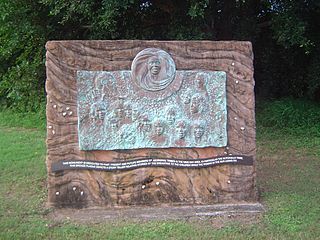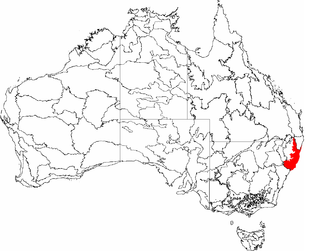History
Camboon Station was a major employer of people from the Wulli Wulli first nation. State Library of Queensland holds the Camboon Station records [4] which record the day to day activities or running the pastoral station including details of the Wulli Wulli peopled employed as drovers and stockmen, shepherds, general station hands and domestic servants. [5]
A very late tradition collected in 1979 states that a certain Jimmy Reid, A Camboon station resident, told a third party before his own death, that the Wulili had participated in the Hornet Bank massacre. In her memoir, the Queensland poet Judith Wright affirmed that, together with the Yiman, who were held responsible for the killings of the Fraser family, the Wulili also were wiped out. John Mathew, however, managed to collect samples of their language from native informants decades later, and published the results in 1926.
The Wiradjuri people are a group of Aboriginal Australian people from central New South Wales, united by common descent through kinship and shared traditions. They survived as skilled hunter-fisher-gatherers, in family groups or clans, and many still use knowledge of hunting and gathering techniques as part of their customary life.
The Goreng Goreng, also known Kooreng Gooreng, are an inland Freshwater Australian Aboriginal people of Queensland, and also a language group. The Goreng Goreng area is between Central West Queensland in the north around Boyne Valley, extending westerly as far as the Great Dividing Range along the Dawes, Auburn, Nogo and Callide Ranges to meet the Wulli Wulli and Ghunghulu to their immediate west over the Great Dividing Range.

The Gubbi Gubbi people also known as Kabi Kabi are an Aboriginal Australian people native to south-eastern Queensland. They are now classified as one of several Murri language groups in Queensland.

The Yirrganydji (Irrukandji) people are an Indigenous Australian people of Queensland who trace their descent from the Irukandji and, as such, are the original custodians of a narrow coastal strip within Djabugay country that runs northwards from Cairns, Queensland to Port Douglas. Their traditional lifestyle was that of fishers along this coastal strip and around the river mouths, islands and seas between the Barron River and Port Douglas.
The Hornet Bank massacre involves the killing of eleven settlers and one Aboriginal station-hand, by a group of Iman Aboriginal Australians. The massacre occurred at about one or two o'clock in the morning of 27 October 1857 at Hornet Bank station on the upper Dawson River near Eurombah in central Queensland, Australia. It has been moderately estimated that 150 Aboriginal people succumbed in subsequent punitive missions conducted by Native Police, private settler militias, and by William Fraser in or around Eurombah district. Indiscriminate shootings of "over 300" Aboriginal men, women, and children, however, were reportedly conducted by private punitive expedition some 400 kilometres eastward at various stations in the Wide Bay district alone. The result was the believed extermination of the entire Iman tribe and language group by 1858; this claim was disputed, however, and descendants of this group have recently been recognised by the High Court of Australia to be the original custodians of the land surrounding the town of Taroom.

The Jagera people, also written Yagarr, Yaggera, Yuggera, and other variants, are the Australian First Nations people who speak the Yuggera language. The Yuggera language which encompasses a number of dialects was spoken by the traditional owners of the territories from Moreton Bay to the base of the Toowoomba ranges including the city of Brisbane.

Nils Magnus Holmer (1905–1994) was a Swedish linguist.
Wuliwuli is an extinct Australian Aboriginal language of the Pama–Nyungan language family formerly spoken by the Wulli Wulli people in Queensland, Australia. The Wulli Wulli language region includes the landscape within the local government boundaries of the North Burnett Regional Council, particularly the town of Eidsvold and the Auburn River catchment, including the properties of Walloon, Camboon, and Hawkwood. Wuliwuli is regarded as a dialect of Wakka Wakka.

Darumbal, also spelt Dharambal, is an Australian Aboriginal language of Queensland in Australia declared extinct. It was spoken in the Rockhampton area of Queensland. Dialects were Guwinmal, Karunbara, Rakiwara, and Wapabura. It is classified with Bayali as a Kingkel language, but the two are not close, with a low 21% shared vocabulary. Indeed, Angela Terrill states that "there is no evidence on which to base a claim of a low-level genetic group including Dharumbal with any other language".
Wakka Wakka, or Waka Waka, people are an Aboriginal Australian community of the state of Queensland.

The Gudjal, also known as the Kutjala, are an Indigenous Australian people of northern Queensland.
The Yiman, also known as Yeeman, Eoman or Jiman, and by themselves in modern times as Iman, are an Aboriginal Australian people living in the Upper Dawson River region around Taroom of eastern Central Queensland.
Mbabaram or Mbabaɽam, often referred to as the Barbaram people, are an Indigenous Australian people living in Queensland in the rainforests of the Atherton Tableland.

The Butchulla, also written Butchella, Badjala, Badjula, Badjela, Bajellah, Badtjala and Budjilla are an Aboriginal Australian people of K'gari, Queensland, and a small area of the nearby mainland of southern Queensland.

The Djangadi people, also spelt Dhungatti, Dainggati, Tunggutti or Dunghutti are an Aboriginal Australian people resident in the Macleay Valley of northern New South Wales.
The Bidia, also called Biria, are an Aboriginal Australian people of the central west and western regions of the state of Queensland. Their language is known as Pirriya.
The Mbewum were an indigenous Australian people of the Cape York Peninsula of northern Queensland. They were dispossessed and became extinct soon after colonization.
The Wanggumara, also spelt Wangkumara, Wongkumara, Wangkumarra, and other variants, are an Aboriginal people of the state of Queensland, Australia.
The Galali or Kalali were an indigenous Australian people of the state of Queensland.
Wild Toby was a famous Aboriginal outlaw from the Dawson River region of central Queensland.
 This Wikipedia article incorporates text from Camboon Station Records (23 June 2021) published by the State Library of Queensland under CC BY licence , accessed on 29 June 2021.
This Wikipedia article incorporates text from Camboon Station Records (23 June 2021) published by the State Library of Queensland under CC BY licence , accessed on 29 June 2021. 






